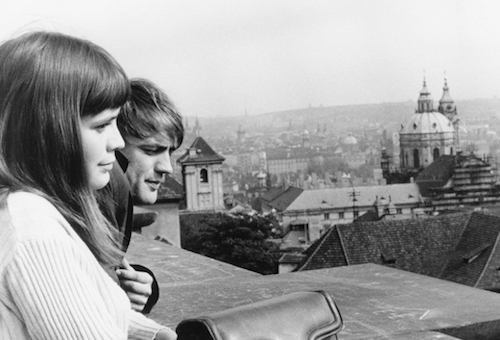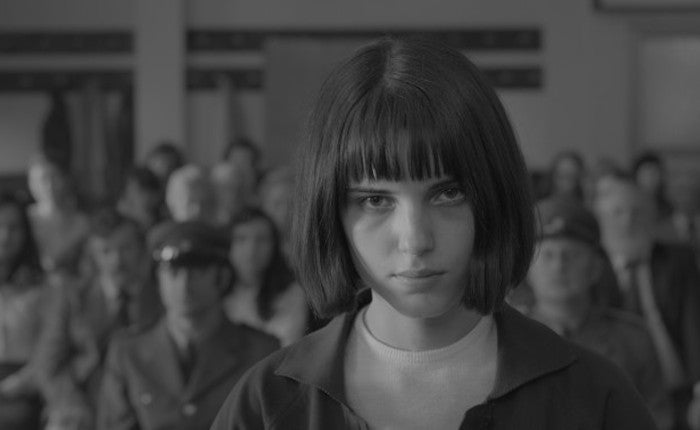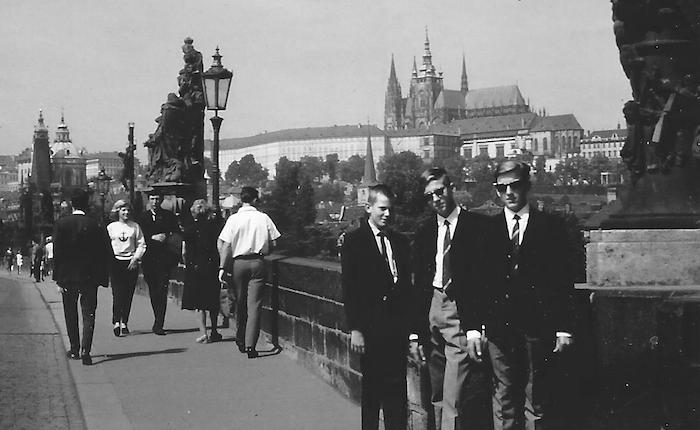
Der sanfte Lauf (1966)
A young woman walks down a cobblestone street in Prague circa 1971. Black and white. Everywhere one looks, the stucco is falling off buildings, window frames seemingly unpainted in years. Slouching pedestrians wearing drab clothing, listlessly go about their business. Traffic is light, a few old Tatras and Skodas, but mostly buses, trams, and trucks roll over the pavement. I strain to recognize a landmark in this city I remember so well, but this is a movie, shot last year in Poland, as the young Czech director tells us after the screening in the Panorama program of the Berlin International Film Festival. Já, Olga Hepnarová [I, Olga Hepnarová] (2016) is the story of a 27-year-old female truck driver who inexplicably mows down over 20 pedestrians with her lorry, then asks for the death penalty, in order to publicize the fact that she has been bullied all her life. As the movie progresses, I’m irritated by other departures from the reality of communist Czechoslovakia as I experienced back then: a lesbian sex scene in a discotheque doesn’t result in the arrest of the participants, as would have undoubtedly happened in reality.
Cut to a young German man and his girlfriend taking a walking tour of Prague in 1966. Black and white and grey. It is winter and the sky is overcast; women in heavy overcoats, workers in dark overalls crowd the city streets. This time I recognize the usual tourist landmarks, the Charles Bridge and Malá Strana, Wenceslas Square, the Tyn Church, the alchemist’s row inside Hradčany Castle. Shot on location, Der sanfte Lauf [The Easy Way Out] (dir. Haro Senft, 1966) stars Bruno Ganz (Wings of Desire) in his very first film role as an electrical engineer suffering from intense alienation in Germany’s postwar “economic miracle.” Ganz, now in his 70s, admits before the screening that he remembers nothing about the film. He does recall wondering why everyone is carrying large, empty bags through the streets, although the shop windows are completely empty. Then, he suddenly sees a queue form, quickly growing to include literally hundreds of shoppers with oversized bags, as the word spreads that a shipment of bananas has arrived. Mr. Ganz repeats an often-used cliché about life under communism, although by the mid-1960s access to consumer goods had significantly improved since the dark days of Stalinism in the 1950s. When the lead character admits in the film that he no longer speaks Czech, even though he was born there, I slip into a deep reverie. Like him, I only understand a bit of Czech, even though I heard the language from the time of my birth.

Já, Olga Hepnarová (2016)
I made my first trip to Prague on Easter 1965 with my parents. I remember grey skies, depressed looking people in badly made clothing and empty shops. At an ugly, “Socialist” pre-fabricated hotel on the city’s outskirts, I flippantly ask my dad where the bugs are hidden, since this is after all a police state? He silently almost takes my head off. Not surprising, since it is his first trip back after 17 years in exile, and a 20-year sentence to Siberia. 30 years later, after the fall of communism and my dad’s move back to the city of his birth, we learn that the Czech Státní bezpečnost (State Security) had not only spied on him and us on that and every subsequent journey to Prague, but that there had been deliberations to arrest him immediately on that first trip. It was only because he was there on business for an American chemical company that supplied Chemapol, a state monopoly, with vital raw materials for the production of refrigerators that its managers won out over the secret police bureaucrats. My dad’s case now fills 40 running feet of banker’s boxes in the state security archives, including photos of the family being tourists in Prague.

Peter, Chris and Michael Horak on Charles Bridge in Prague, summer of 1965.
Today Prague is one of the most beautifully restored cities in Europe, its architecture a melange of vibrant color. I visit regularly to see my twin, Michael, who lives there. Taking a bus from the airport, hearing Czech spoken all around me, my emotions are almost always identical: a mixture of intense familiarity, even nostalgia, and simultaneous otherness, because I still only understand individual words and not sentences. Each new street corner reminds of some event from the past, the ghosts of my dad, grandparents, aunts and uncles accompanying me. Just like watching a Czech film from 1966, past and present, dream and reality, emotion and logic, black and white and color, intermingle and are no longer distinguishable. That is the power of cinema.
< Back to Archival Spaces blog






 Mobile Navigation
Mobile Navigation

